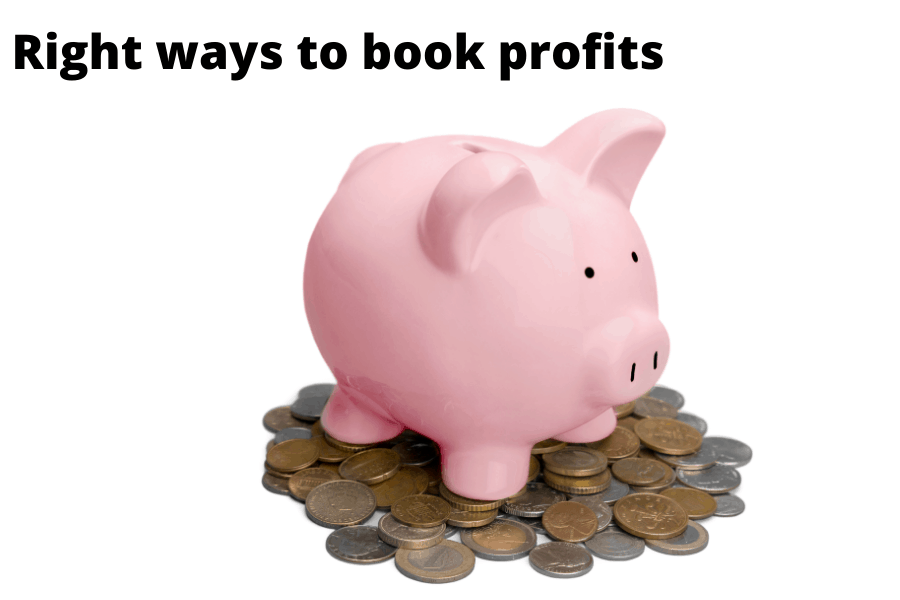With Indian stock markets at an all-time high valuation despite uncertainty about the shape of earnings recovery, it is not surprising that many investors want to book profits and take some money off the table ahead of New Year. There could be three legitimate reasons for you to sell some of your equity holdings.
- If you have financial goals coming up within the next three years and don’t want your healthy-looking portfolio to be mauled by the bear, selling can help you cash out on current gains.
- If you began with a moderate allocation of say, 50%, 60% or 70% to equities, but have seen it zoom to far higher levels in this rally, it is good for you to rebalance and get back to your pre-decided allocation by selling equities and investing in FDs, debt instruments or gold with that money.
- If the size of equity gains you’re sitting on isn’t letting you sleep at night and market blips like the one we saw this week are causing you anxiety, this is a sure sign that you’re carrying more risk than you can take. It would be wise for you to convert some of the paper gains on your portfolio into real money.

But selling your equity exposures when your portfolio’s doing great can be quite a difficult decision to make. What should you sell, how much you sell and when should you sell? Here are a few suggestions.
#1 Don’t make all-or-nothing calls
You’re quite convinced that stock market is over-valued and headed for big crash like in 2008 or even March 2020. If this conviction is urging you to book profits on all or most of your equity holdings to sit on cash, think twice before acting.
For one, market tops are as difficult to predict as market bottoms. Though no one can dispute that stock markets are frothy today, there’s no saying how a correction will play out or when it will play out. Global gurus have been calling an end to this central bank-induced stock bubble for the last five years but have been repeatedly frustrated. Much of wealth in the stock market, after all, is generated in short bursts of activity, speculative or not.
Two, if long-term wealth creation is your objective, you will need a sizeable equity allocation in your portfolio most of the times to achieve it. If you sell a bulk of your stock holdings today, you’ll also need to redeploy that cash in equities as early as possible in future, so that you don’t miss out on the benefit of earnings compounding. But watching the markets closely enough to find the right time to re-enter won’t be easy. Even if you’re an ace at identifying market tops and bottoms and have the nerves of steel to buy during maximum panic, finding good stocks to buy(as good as or better than the ones you sold) for all your cash is an uphill task. The bounce-back from the March 2020 correction and the rebound from the March 2009 lows were both so rapid that investors who were sitting on cash would have had barely enough time to build a quality portfolio.
Stick to a minimum equity allocation at all times, churning only a portion of your equity portfolio for tactical calls.
Given the difficulty of moving large portions of your portfolio in and out of equities at short notice, stick to a minimum equity allocation at all times, churning only a portion of your portfolio for tactical calls. In a Rs 50 lakh portfolio for instance, you can peg the minimum equity exposure at 50% (Rs 25 lakh) and maximum at 80% (Rs 40 lakh) based on your comfort levels. If you believe the markets to be in a frothy phase, you can book profits on any portion of your portfolio that exceeds your minimum threshold. If your equity value is Rs 40 lakh, you can liquidate Rs 15 lakh worth of holdings (the excess over minimum) and leave the rest untouched.
#2 Phase out your sells
In the stock market, timing is a big decider of your returns. That goes not just for the timing of your entry into a stock but also the timing of your exit. If you took a lot of care to time your entry into a stock by buying it in several lots or averaging it over time through SIPs, it is critical that you take the same care with your sells too. If you don’t have specific valuation targets at which you plan to sell a stock, apply the SWP method and sell your holdings in equal lots phased out over time. Don’t panic at a single market blip and get rid of all your positions at one go. A quick bounce-back can fill you with regret.
#3 Go by valuations, not percentage gains
One of the hardest decisions you make as an equity seller is deciding what stock to hold and what to let go. There’s no dearth of advice on this. Some investors ask you to sell positions sporting big gains – say 100% or more. Others ask you to sell just enough shares to recoup your initial investment, so that you can hold the remaining shares “free of cost”. Yet others advise taking money off the table when you’ve hit a target return of say 20% or 25%.
All these strategies are more suitable for short-term traders than long-term investors looking to create some serious wealth through equities. Many of the top wealth creating stocks in the Indian market have delivered a 20% plus CAGR over 25 years. A 20% CAGR on a stock reflects its price doubling roughly every four years. Imagine where you would be if you sold out after the first 100% gain!
To give a live example, on an adjusted price basis, the stock of Kotak Mahindra Bank zoomed from about Rs 10 in January 2005 to over Rs 300 by December 2007. But investors who cashed out then bedazzled by the 30-fold gain, would be kicking themselves today for losing out the next 17 years of solid wealth creation which has taken its price to Rs 1900 levels!
Rather than absolute returns, choose your sell candidates based on valuations indicators such as price-earnings or price to book value ratio, compared to the market and peers. If these valuation metrics aren’t sky-high, look out for another candidate.
Your main objective when adding a new company to your long-term equity portfolio is to benefit from earnings compounding. This argues for using fundamental and not price or return triggers to make your sell decisions. Here are some pointers when choosing a sell candidate:
- Hunt for companies whose earnings or revenues are showing a persistent downturn (ideally for several quarters and not one), those that are reporting margin or return on equity compression or those that are building up debt levels.
- Rather than absolute returns, choose your sell candidates based on valuations indicators such as price-earnings or price to book value ratio, compared to the market and its peers. If these valuation metrics aren’t sky-high, look out for another candidate.
- PE and P/BV are a simple way to assess if a stock’s price run up way ahead of its earnings growth. For instance, if you are an investor who bought Coromandel International five years ago at Rs 190 (adjusted price), you’ve made handsome gains on the stock which is at Rs 770 today. Using absolute return metrics may tempt you to sell the stock, but its PE today is exactly the same as five years ago, at about 17 times. This is thanks to steady earnings growth which has seen its EPS grow from Rs 11 five years ago to Rs 46 now. Clearly, this is an earnings compounder that you shouldn’t be exiting in a hurry.
- The same logic also argues for selling your low-conviction bets, ahead of high-conviction bets where you’ve put in a lot of homework. During bull markets, most of us do get tempted to acquire companies in businesses that we don’t really understand or follow very well. You may acquire such stocks based on tips or taking cues from big-name investors. If you’ve been lucky with such stocks, do sell them ahead of those where you have high personal knowledge and conviction in the business and its fundamentals.
#4 Exit loss-making positions
Retail investors are famous for cutting the flowers and watering the weeds in their portfolios (Warren Buffett’s quote, not ours!) The most common mistake they make is to book profits too early on their profitable stocks (probably based on target returns) and to hold on in everlasting hope to their loss-making positions. In the long run, this results in an equity portfolio that has a long tail of dud stocks and just a handful of fundamentally sound compounders.
When assessing your portfolio for sells therefore, don’t be obsessed with booking a profit on a stock which has delivered. Be quite ready to cut losses on those that haven’t too.
It would be best to start your stock-taking with the loss-makers. If a stock you own is in the red after this five-year old bull market, it can either mean that your buy price was excessively high or that the company’s earnings or fundamentals have gone downhill.
In fact, today it would be best to start your stock portfolio with the loss-makers. If a stock you own is in the red after this five-year old bull market, it can either mean that your buy price was excessively high or that the company’s earnings or fundamentals have gone downhill since your purchase.
While selling penny stocks that make up the tail of your portfolio may not really yield much cash or de-risk you, the capital losses you book on such holdings can come in handy to reduce your capital gains tax outgo on the stocks that made you a neat profit while selling.
#5 Don’t sell without a redeployment plan
Finally, whether you’re selling some stocks due to over-valuation or profit booking to take some money off the table, do have a clear plan in mind on how you propose to deploy the money.
- If you have financial goals coming up, that’s a good thing. But if you don’t, plan out where you’ll invest the proceeds.
- If you’ve sold stocks to tactically reduce your equity allocation until markets get cheaper, be sure to reinvest the proceeds in an instrument that offers liquidity at a time of your choice. Should a sharp stock market correction come along you wouldn’t want to be out of cash to reinvest.
- Having gotten out at the right time, getting back into equities during a bear rampage can also be quite difficult. Set specific valuation targets for the markets at large or for the stocks you own at which you would be happy to re-enter them. This will take the emotion out of your buy decision.
- If you don’t much fancy the stocks you sold, create a wish-list of companies that you always wanted to own and do your homework on their business. This will make redeployment easy when opportunity knocks at your door.
More reading: Our earlier article on profit booking from mutual funds can be read from here.



